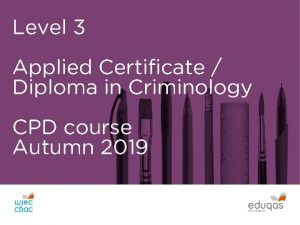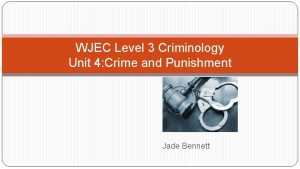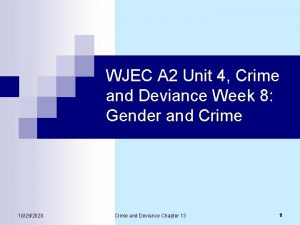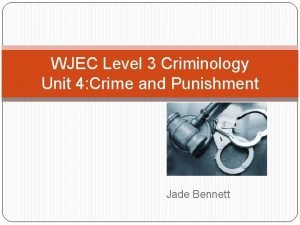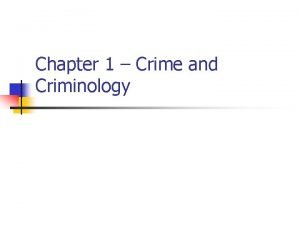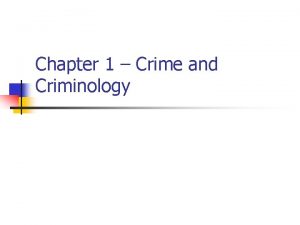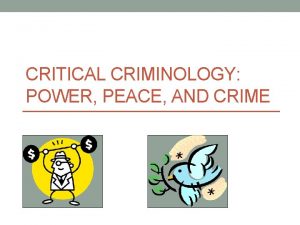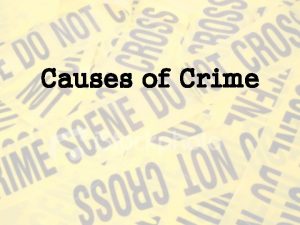WJEC Level 3 Criminology Unit 4 Crime and











- Slides: 11

WJEC Level 3 Criminology Unit 4: Crime and Punishment Jade Bennett

Reflection Activity Purple booklets �Describe the process of passing a Bill �Describe the relationships of the police with other agencies in the criminal justice system. �Describe the process of creating laws through a judicial precedent. Feedback through class discussion.

Learning objectives AC 1. 3 Describe models of criminal justice Models of criminal justice �due process �crime control Synoptic links: Learners will draw on their understanding of criminological theories in Unit 2 and their review of criminal verdicts in Unit 3 to gain awareness of the application of these models.

Models of justice What does it mean? ? A Framework for Understanding the Future of Criminal Justice In his influential 1968 book entitled The Limits of the Criminal Sanction, legal scholar Herbert Packer describes the criminal justice process in the U. S. as the outcome of competition between two value systems: • The crime control model • The due process model

Crime control model One of Packer’s two models of the criminal justice process. It reflects traditional politically conservative values. In this model, the control of criminal behaviour is the most important function of criminal justice. Group discussion Which theorists would support this model? What methods of control/government initiatives might they support? Synoptic link to unit 2!!!

Advocates of the crime control model want to make the process more efficient—to move cases through the process as quickly as possible and to bring them to a close. Packer characterizes the crime control model as “assembly-line justice. ” Crime control advocates prefer plea bargaining to jury trials, which slow down the process. The key to the crime control model is “a presumption of guilt”—if a person has been arrested and charged, they must be guilty. Are there any potential limitations of this model?

Due process model due process model One of Packer’s two models of the criminal justice process. It embodies traditional politically liberal values. In this model, the principal goal of criminal justice is at least as much to protect the innocent as it approach supports this model and why? Which realist is to convict the guilty.

The due process model is based on the doctrine of legal guilt and the presumption of innocence. This model places value on the protection of all individuals by the law, victims and suspects alike. This models views the justice system as an obstacle course that ensures fairness to all Group activity involved to ensure a fair and just verdict is reached. Match up the following statements under the correct model of crime control. Crime control model Due process

The future of law enforcement If the future of law enforcement increasingly reflects the principles and policies of the crime control model, then we might expect fewer limitations on how the police attempt to combat crime. Greater intrusion into people’s lives will be facilitated by advances in electronic surveillance. Technological advances will continue in the future. On the other hand, if we see a shift to the principles and policies of the due process model, we should expect existing limitations on how the police combat crime to remain intact or even be expanded.

DNA profiling One new development is DNA profiling, which will probably become a routine law enforcement tool in the near future. Perhaps the most thorny issue with DNA Activity: profiling is how the DNA database In be groups of 2, you will each either will support and the due process or crime collected used. control model in relation to the development of DNA profiling. You must conduct your own research to support your views and be ready to have a debate with the other group. If the due process model prevails, the DNA database will probably comprise samples taken only from booked suspects, as is the current practice with fingerprints. If the crime control model prevails, the DNA database may comprise DNA samples taken shortly after birth from all infants born in the U. S.

An eye on the exam: The town of Fainton has recently suffered from a large number of burglaries. Despite the police investing a great deal of time and resources into investigating and detecting the crimes, they are still continuing. A senior police officer has been on a fact-finding mission to America to review how environmental design can have an impact on crime control. The police officer has returned and is very impressed with what she has found and is trying to convince the local Police and Crime Commissioner that he should consider this approach to social control. (a) Describe two models of criminal justice. i) (2 marks) ii) (2 marks)
 Criminology unit 4 revision
Criminology unit 4 revision Ac3.1 examine information for validity
Ac3.1 examine information for validity Wjec criminology unit 4 revision
Wjec criminology unit 4 revision Unit 4 criminology revision
Unit 4 criminology revision Wjec criminology unit 2 exam 2020
Wjec criminology unit 2 exam 2020 Ac1.3 criminology unit 1
Ac1.3 criminology unit 1 Wjec unit 3 english language
Wjec unit 3 english language Eduqas a level english literature
Eduqas a level english literature Eduqas english language and literature
Eduqas english language and literature Wjec hospitality and catering unit 2 examples
Wjec hospitality and catering unit 2 examples Eduqas hospitality and catering
Eduqas hospitality and catering Wjec hospitality and catering unit 2 examples
Wjec hospitality and catering unit 2 examples

